生命周期函数指在某一时刻组件自动执行的函数。
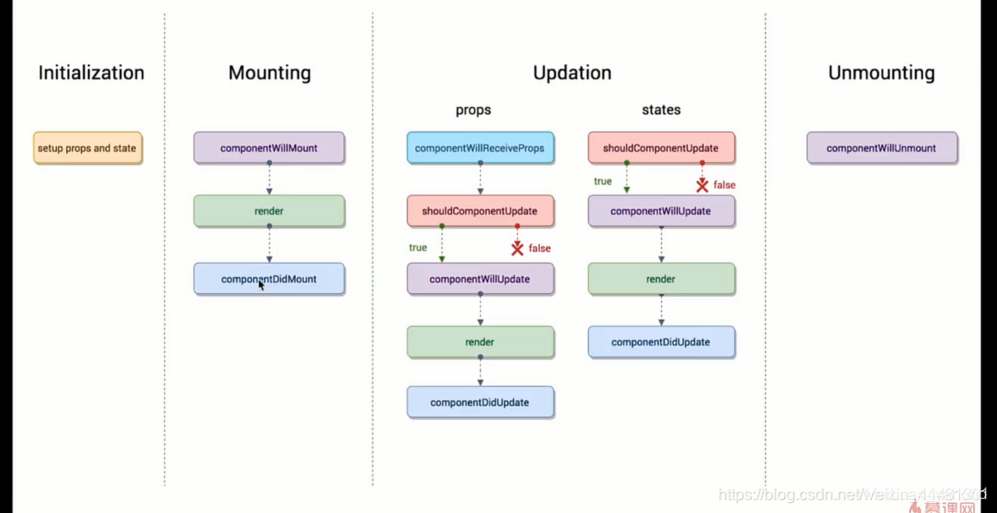
2.mount挂载
componentWillMount – render – componentDidMount
组件即将被挂载到页面上–挂载–组件被挂载到页面上之后执行
componentWillMount, componentDidMount只会在第一次的时候执行
3.update更新
组件更新有两种情况
1.props发生变化
2.states发生变化
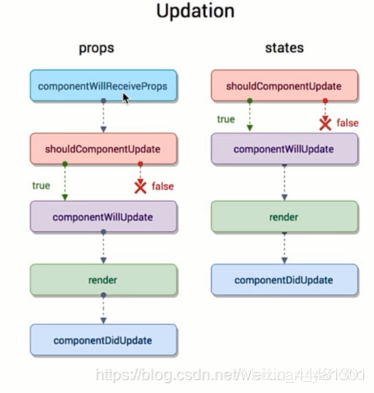
shouldComponentUpdate在组件被更新之前被执行
(返回true或false来决定组件是否需要被更新)

componentWillUpdate在组件更新之前,shouldComponentUpdate之后执行, 只有shouldComponentUpdate返回的值是true它才会执行
componentDidlUpdate在组件更新之后执行
比较特殊的componetWillReceiveProps是在组件有接收props参数的情况下它才会执行
1.组件要从父组件接受参数
2.如果这个组件第一次存在于父组件中,不会执行
3.如果这个组件之前已经存在于父组件中,才会执行
4.unmount把组件从页面剔除
componentWillUnmount组件即将被移除的时候执行
父子组件生命周期执行顺序
1、组件生命周期的执行次数是什么样子的???
只执行一次: constructor、componentWillMount、componentDidMount
执行多次:render 、子组件的componentWillReceiveProps、componentWillUpdate、componentDidUpdate
有条件的执行:componentWillUnmount(页面离开,组件销毁时)
不执行的:根组件(ReactDOM.render在DOM上的组件)的componentWillReceiveProps(因为压根没有父组件给传递props)
2、组件的生命周期执行顺序是什么样子的???
假设组件嵌套关系是 App里有parent组件,parent组件有child组件。
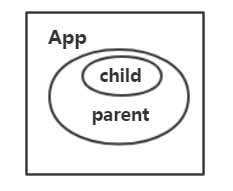
如果不涉及到setState更新,第一次渲染的顺序如下:
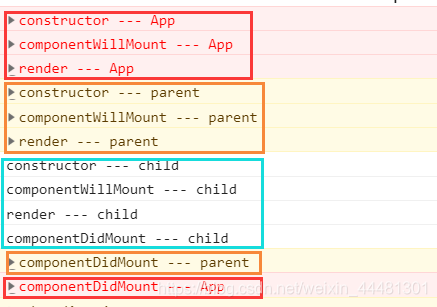
App: constructor --> componentWillMount --> render -->
parent: constructor --> componentWillMount --> render -->
child: constructor --> componentWillMount --> render -->
componentDidMount (child) --> componentDidMount (parent) --> componentDidMount (App)
这时候触发App的setState事件
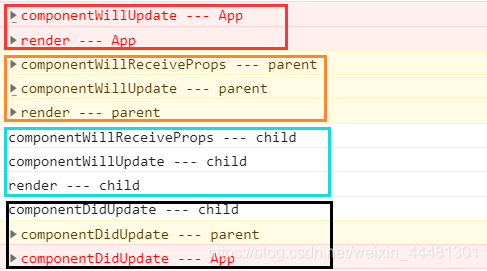
App: componentWillUpdate --> render -->
parent: componentWillReceiveProps --> componentWillUpdate --> render -->
child: componentWillReceiveProps --> componentWillUpdate --> render -->
componentDidUpdate (child) --> componentDidUpdate (parent) --> componentDidUpdate (App)
那如果是触发parent的setState呢?

parent: componentWillUpdate --> render -->
child: componentWillReceiveProps --> componentWillUpdate --> render -->
componentDidUpdate (child) --> componentDidUpdate (parent)
那如果是只是触发了child组件自身的setState呢?

child: componentWillUpdate --> render --> componentDidUpdate (child)
结论:
1、如图:完成前的顺序是从根部到子部,完成时时从子部到根部。(类似于事件机制)
2、每个组件的红线(包括初次和更新)生命周期时一股脑执行完毕以后再执行低一级别的红线生命周期。

3、第一级别的组件setState是不能触发其父组件的生命周期更新函数,只能触发更低一级别的生命周期更新函数。
提问:那么这里提一个问题,如果App里面有多个parent1 parent2 …,parent里由多个child,那么生命周期执行顺序应该时什么样的????
结论:一套组件(父包括子,子包括孙)执行的时候一个整体,执行完毕在执行下一套,用到这里就是App里先执行parent1和parent1的子,子的子。。。,然后完毕再执行parent2这一套。








 本文介绍了组件生命周期函数,包括mount挂载、update更新、unmount剔除阶段的相关函数,如componentWillMount、shouldComponentUpdate等。还探讨了父子组件生命周期的执行顺序,指出完成前从根部到子部,完成时从子部到根部,且一套组件执行完再执行下一套。
本文介绍了组件生命周期函数,包括mount挂载、update更新、unmount剔除阶段的相关函数,如componentWillMount、shouldComponentUpdate等。还探讨了父子组件生命周期的执行顺序,指出完成前从根部到子部,完成时从子部到根部,且一套组件执行完再执行下一套。
















 7196
7196

 被折叠的 条评论
为什么被折叠?
被折叠的 条评论
为什么被折叠?








